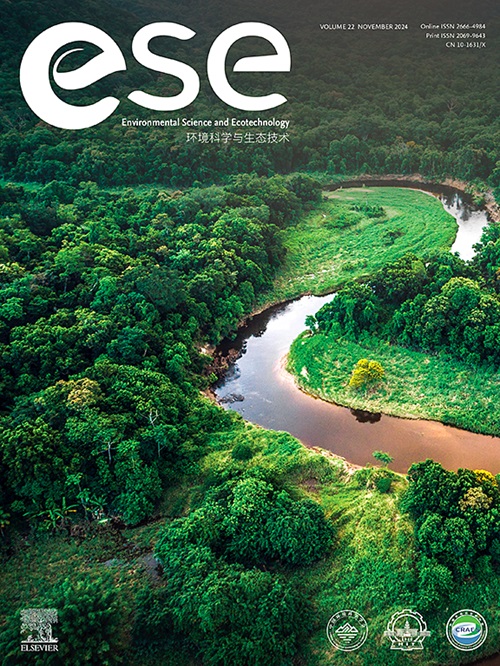可持续水净化和风险管理的氧化还原调节
IF 14.3
1区 环境科学与生态学
Q1 ENVIRONMENTAL SCIENCES
引用次数: 0
摘要
废水中有毒有机污染物(TOPs)的可持续解毒和深度处理对水回收和生态系统安全至关重要。虽然生物处理是一种低碳、环保的降解TOPs的方法,但其效果往往受到TOPs的高毒性和难降解性的限制。氧化和还原反应可以根据其固有的氧化还原电位来降解TOPs。然而,传统的生物或化学氧化处理往往不能有效或有目的地切割关键官能团,从而导致生物反应性能不理想或化学氧化成本过高。这一观点提出,氧化还原调节是一种适度催化TOPs氧化或还原的策略,从而产生低毒性和增加可生物降解的中间体,这将改善后续的生物处理。本文综述了强氧化还原调控技术,包括高级氧化还原过程和低能量电位弱氧化还原调控技术,以及相应的机制和应用。此外,我们探索了氧化还原调控与生物处理的整合,无论是在顺序模式还是在原位。本研究强调了未来的研究需要关注有针对性和持久的催化解毒过程,并优化平衡碳足迹,过程控制,操作效率和经济可行性。通过将化学反应与微生物代谢相结合,氧化还原调控有可能将废水处理从孤立的过程优化转变为整体方法。这一观点提倡创新传统的废水解毒技术,以实现可持续的水净化和生态风险控制。本文章由计算机程序翻译,如有差异,请以英文原文为准。
Redox regulation for sustainable water purification and risk management
Sustainable detoxification and advanced treatment of toxic organic pollutants (TOPs) in wastewater are essential for water reclamation and ecosystem security. Although biological treatment is a low-carbon and eco-friendly approach for TOPs degradation, its effectiveness is often limited by the high toxicity and recalcitrance of TOPs. Oxidative and reductive reactions can degrade TOPs according to their intrinsic redox potentials. However, conventional biological or chemical oxidation treatment often fails to efficiently or purposefully cleave key functional groups, which leads to unsatisfactory performance of biological reactions or excessive chemical oxidation costs. This perspective proposes redox regulation as a strategy to moderately catalyse the oxidation or reduction of TOPs and thereby generate low toxicity and increased biodegradable intermediates, which will improve subsequent biological treatment. We summarize strong redox regulation techniques, including advanced oxidation and reduction processes, and weak redox regulation through low-energy electrical potential, along with the corresponding mechanisms and applications. Additionally, we explore the integration of redox regulation with biological treatment, either in a sequential mode or in situ. This study emphasizes the need for future research to focus on targeted and durable catalytic detoxification processes and to optimize balancing the carbon footprint, process control, operational efficiency, and economic feasibility. By integrating chemical reactions with microbial metabolism, redox regulation has the potential to transform wastewater treatment from isolated process optimization to a holistic approach. This perspective advocates for innovation of conventional wastewater detoxification technologies to achieve sustainable water purification and ecological risk control.
求助全文
通过发布文献求助,成功后即可免费获取论文全文。
去求助
来源期刊

Environmental Science and Ecotechnology
Multiple-
CiteScore
20.40
自引率
6.30%
发文量
11
审稿时长
18 days
期刊介绍:
Environmental Science & Ecotechnology (ESE) is an international, open-access journal publishing original research in environmental science, engineering, ecotechnology, and related fields. Authors publishing in ESE can immediately, permanently, and freely share their work. They have license options and retain copyright. Published by Elsevier, ESE is co-organized by the Chinese Society for Environmental Sciences, Harbin Institute of Technology, and the Chinese Research Academy of Environmental Sciences, under the supervision of the China Association for Science and Technology.
 求助内容:
求助内容: 应助结果提醒方式:
应助结果提醒方式:


